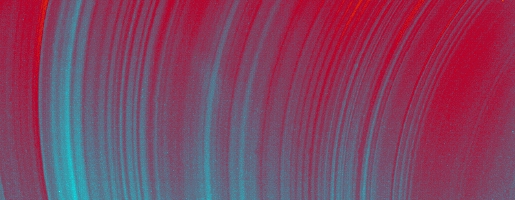 |
||||||||||||||||||||||||||||||||||||||||||||||||||||||||||||||||||||||||||||||||
|
The
Voyager spacecraft revealed the rings to be far more complex than previously
thought.
|
||||||||||||||||||||||||||||||||||||||||||||||||||||||||||||||||||||||||||||||||
| THE RINGS OF SATURN | ||||||||||||||||||||||||||||||||||||||||||||||||||||||||||||||||||||||||||||||||
| The rings of Saturn are one of the most spectacular and best-loved sights in the Solar System. Of the gas-giants' rings, Saturn's are the most splendid. | ||||||||||||||||||||||||||||||||||||||||||||||||||||||||||||||||||||||||||||||||
| Discovery | ||||||||||||||||||||||||||||||||||||||||||||||||||||||||||||||||||||||||||||||||
| They were first seen by Galileo in 1610, using the newly invented telescope. Galileo though was not sure what to make of them and his early drawings show a triple planet, because the rings he saw jutting out either side looked like spheres. Other observers drew Saturn with handles attached. It was Christiaan Huygens in 1659 who worked out that Saturn was girdled by a disk. | ||||||||||||||||||||||||||||||||||||||||||||||||||||||||||||||||||||||||||||||||
| Overview | ||||||||||||||||||||||||||||||||||||||||||||||||||||||||||||||||||||||||||||||||
| The rings are very bright. They are in fact brighter than Saturn itself, making the planet appear particularly brilliant when they are tilted, presenting more of their surface, towards Earth. The angle of the rings varies because Saturn's equator is at an angle of 28o and as it moves around the Sun, we see it from a different view-point. When the rings are seen edge on, Saturn from Earth looks much dimmer. | ||||||||||||||||||||||||||||||||||||||||||||||||||||||||||||||||||||||||||||||||
| At such times the rings seem to disappear from view completely because they are very thin. This happens at intervals of 13.75 and 15.75 years. The two year difference in the interval is because the orbit of Saturn is slightly elliptical. | ||||||||||||||||||||||||||||||||||||||||||||||||||||||||||||||||||||||||||||||||
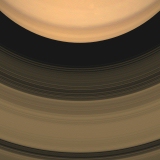 Map of Saturn's rings and moons. |
||||||||||||||||||||||||||||||||||||||||||||||||||||||||||||||||||||||||||||||||
| Saturn has three main rings. Moving inwards, these are the A (outer), B, and C rings. The C ring is less bright than A and B, and is known as the Crepe or Dusky Ring. The A and B rings are separated by a sharp division. This 4000 kilometres gap is called the Cassini Division after its discoverer. | ||||||||||||||||||||||||||||||||||||||||||||||||||||||||||||||||||||||||||||||||
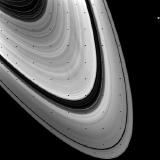 Voyager view of Saturn's ring system. |
||||||||||||||||||||||||||||||||||||||||||||||||||||||||||||||||||||||||||||||||
| The Cassini Division, and others like the Encke and the Keeler Gap, are thought to be relatively clear because they are swept clean by shepherd moons and very tiny moonlets. The gravitational effect of the moons upon small particles is to send them into new orbits free of the satellites influence. | ||||||||||||||||||||||||||||||||||||||||||||||||||||||||||||||||||||||||||||||||
| Another means by which the gaps could be cleared is that they are resonant locations. In other words, periodic alignments between two or more bodies may exert an extra gravitational force on a particular orbital zone, keeping it clear of material. As such, it is possible that the ring system forms an analogy with the Solar System in general. The gaps swept clear by such resonances resemble the Kirkwood gaps of the asteroid belt which are evacuated because they are resonant locations with respect to Jupiter. | ||||||||||||||||||||||||||||||||||||||||||||||||||||||||||||||||||||||||||||||||
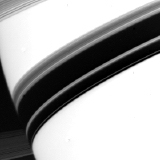 Saturn's rings cast a shadow onto Saturn's atmosphere. |
||||||||||||||||||||||||||||||||||||||||||||||||||||||||||||||||||||||||||||||||
| Saturn's other rings are very wispy and hard to see. They were discovered by spacecraft which visited the Saturnian system. The F ring was found by Pioneer 11 and the Voyager spacecraft located rings G and E. The most exciting discovery of the Voyager mission was not these ghost-like bands but the amazing detail which could be seen in the opaque rings. It was anticipated that there might be a few gaps, regions swept clean by the inner moons, but the Voyager images astounded researchers. They revealed thousands of fine rings, and thousands of gaps. | ||||||||||||||||||||||||||||||||||||||||||||||||||||||||||||||||||||||||||||||||
|
||||||||||||||||||||||||||||||||||||||||||||||||||||||||||||||||||||||||||||||||
| Composition | ||||||||||||||||||||||||||||||||||||||||||||||||||||||||||||||||||||||||||||||||
| The rings are made up of small rocks. These range in size from the tiniest grains to metre-sized boulders. The larger rocks, however, are less common. Though most of the material which makes up the rings are in the centimetre size range, there is also a lot of dust. Radar measurements tell us what size the larger particles are because from the beam-scattering properties the roughness of the ring's surface can be determined. In terms of depth, it is assumed that the B ring is the thickest. The Voyager flyby indicated that the rings, even here, are only about 150 metres deep. Despite the large size, a diameter of 270,000 kilometres, the ring system is calculated to have a mass roughly the same as Mimas. | ||||||||||||||||||||||||||||||||||||||||||||||||||||||||||||||||||||||||||||||||
| Spectral studies (analysis of reflected light) indicate that some of the bands show absorption by water ice and probably have a similar composition to the satellites. The Voyager mission showed that even in the apparently clear gaps, there are faint rings, just about visible. Even the Cassini Division, which was once thought to be absolutely clear of material has faint rings within it. The faint rings appear to be similar in make-up to the inner C ring, containing fewer red coloured particles than the brighter rings. | ||||||||||||||||||||||||||||||||||||||||||||||||||||||||||||||||||||||||||||||||
| Spokes | ||||||||||||||||||||||||||||||||||||||||||||||||||||||||||||||||||||||||||||||||
| Voyager images of the B ring revealed radial spokes. They can appear dark or bright depending on the direction from which they are illuminated. The larger spokes are about 10,000 kilometres long and as much as 2000 kilometres wide; many of them are wedge-shaped. They appear to be unique to the B ring. Though the spokes can persist for several hours, images which where taken in succession by the Voyager spacecraft show that the spokes are distorted as the system spins. | ||||||||||||||||||||||||||||||||||||||||||||||||||||||||||||||||||||||||||||||||
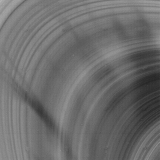 The origin of the spokes is still not fully understood. |
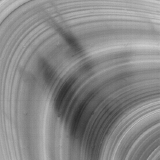 The structure of the spokes distorts as the rings spin. |
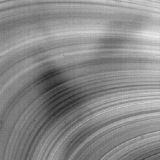 The spokes may be particles slightly above the ring plane. |
||||||||||||||||||||||||||||||||||||||||||||||||||||||||||||||||||||||||||||||
| The outer part of an individual spoke rotates more slowly than the inner part. It is still not known how they form but are best explained as clouds of dust size particles which interact in some way with the magnetic field. Some research shows that the particles which form the spokes occupy a slightly different plane to the main surface of the ring, which is why they scatter light differently, but the details of how the radial pattern is generated is not clear at all. | ||||||||||||||||||||||||||||||||||||||||||||||||||||||||||||||||||||||||||||||||
| D ring | ||||||||||||||||||||||||||||||||||||||||||||||||||||||||||||||||||||||||||||||||
| The D ring is not very remarkable. It is vague and diffuse. The outer part has a hazy edge while the inner part fades out more gradually, disappearing completely a few thousand kilometres from Saturn's upper cloud deck. This inward bloom is reminiscent of Jupiter's inner Halo ring, which appears to be made up of particles from the main ring falling towards the planet. | ||||||||||||||||||||||||||||||||||||||||||||||||||||||||||||||||||||||||||||||||
| C ring | ||||||||||||||||||||||||||||||||||||||||||||||||||||||||||||||||||||||||||||||||
| Moving outwards the C ring is encountered. It is the faintest of the rings known from Earth-based observations, but was revealed by Voyager to have a complex structure. On a broad scale it has three main bands and two main gaps. A close look shows there to be very many narrow rings within the empty gaps in addition to the more densely grouped rings which together make up the bands. | ||||||||||||||||||||||||||||||||||||||||||||||||||||||||||||||||||||||||||||||||
| Voyager also made the surprising discovery that some of the C rings are eccentric. The deviation from a circular pattern is probably caused by very small moons or irregularities in the make-up of the ring. It has also been suggested that alignments with the larger satellites may deform the orbit of the rings. | ||||||||||||||||||||||||||||||||||||||||||||||||||||||||||||||||||||||||||||||||
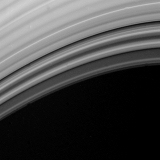 The C ring is the faintest ring visible from Earth. |
||||||||||||||||||||||||||||||||||||||||||||||||||||||||||||||||||||||||||||||||
| B ring | ||||||||||||||||||||||||||||||||||||||||||||||||||||||||||||||||||||||||||||||||
| The B ring is the brightest, it is opaque and very substantial looking. The B ring extends from the outer boundary of the C Ring to the inner edge of the Cassini Division, occupying a zone from 25,000 to 54,000 kilometres above Saturn's cloud deck. Close examination of Voyager images shows that the particles which make up the B Ring are redder than either the C or D ring fragments. Radar results show they are bigger. Moving inwards towards Saturn the ring appears to thin out, becoming more transparent. Where the B ring becomes fainter it is met by the edge of the C ring. | ||||||||||||||||||||||||||||||||||||||||||||||||||||||||||||||||||||||||||||||||
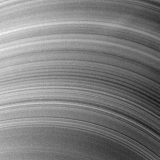 Saturn's B ring is the brightest ring. |
||||||||||||||||||||||||||||||||||||||||||||||||||||||||||||||||||||||||||||||||
| A ring | ||||||||||||||||||||||||||||||||||||||||||||||||||||||||||||||||||||||||||||||||
| The A ring, separated from the bright inner B ring by the Cassini Division, is slightly fainter and less wide, has a sharp inner boundary. Just as ring B grades away towards Saturn, ring A fades outwards gradually becoming more diffuse further out. The faint outer edge of the A ring terminates at the orbit of Atlas. It is thought that Atlas helps maintain a crisp edge by sweeping up debris that might otherwise give the boundary a fuzzy appearance. | ||||||||||||||||||||||||||||||||||||||||||||||||||||||||||||||||||||||||||||||||
 The orbits of Pan, Atlas, and Prometheus. |
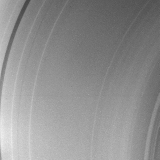 Saturn's A ring. |
|||||||||||||||||||||||||||||||||||||||||||||||||||||||||||||||||||||||||||||||
| The A ring contains a clear division known as the Encke Gap. As with the Cassini Division the A ring gap is not totally devoid of material and contains faint ringlets. The rings within the Encke gap have some peculiar traits. They vary in brightness along their length which can make them appears interrupted. One of the rings is slightly crooked, possibly due to the presence of a small moon disrupting the particles which make up the ring. | ||||||||||||||||||||||||||||||||||||||||||||||||||||||||||||||||||||||||||||||||
 The A ring contains the Encke Gap. |
||||||||||||||||||||||||||||||||||||||||||||||||||||||||||||||||||||||||||||||||
| F ring | ||||||||||||||||||||||||||||||||||||||||||||||||||||||||||||||||||||||||||||||||
| Continuing outwards, the narrow (3 kilometres) F ring is encountered, bounded by the orbits of Pandora and Prometheus. Though the F ring is slender and very faint, Voyager images showed that it is made of three lines of material which interweave. The F ring is sometimes referred to as the "braided ring". Continued observations revealed more filaments but the braiding is not continuous and the rings straighten out. | ||||||||||||||||||||||||||||||||||||||||||||||||||||||||||||||||||||||||||||||||
 The braided F ring. |
||||||||||||||||||||||||||||||||||||||||||||||||||||||||||||||||||||||||||||||||
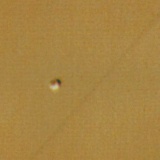 Voyager 2 image showing Prometheus and part of the faint F ring against the background of Saturn. |
 The orbits of Pan, Atlas, and Prometheus. |
|||||||||||||||||||||||||||||||||||||||||||||||||||||||||||||||||||||||||||||||
 Pandora and Prometheus shepherding the F ring. |
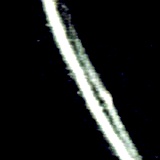 The braided F ring consists of three interwoven braids. |
|||||||||||||||||||||||||||||||||||||||||||||||||||||||||||||||||||||||||||||||
| G and E rings | ||||||||||||||||||||||||||||||||||||||||||||||||||||||||||||||||||||||||||||||||
| Beyond the F ring are the wider but more tenuous G and E rings. The G ring is located 170,000 kilometres from the centre of Saturn and is 8000 kilometres wide, its presence was hinted at by the Pioneer spacecraft but was not positively identified until the Voyager flyby. The outermost E ring is 300,000 kilometres wide, it extends from just within the orbit of Mimas beyond that of Rhea , becoming progressively more diffuse and transparent, but thicker. The brightest part of the E ring coincides with the orbit of Enceladus, it is possible that active volcanism erupts fine particles which stream out, maintaining the brightness of the ring in its path. | ||||||||||||||||||||||||||||||||||||||||||||||||||||||||||||||||||||||||||||||||
|
|
||||||||||||||||||||||||||||||||||||||||||||||||||||||||||||||||||||||||||||||||